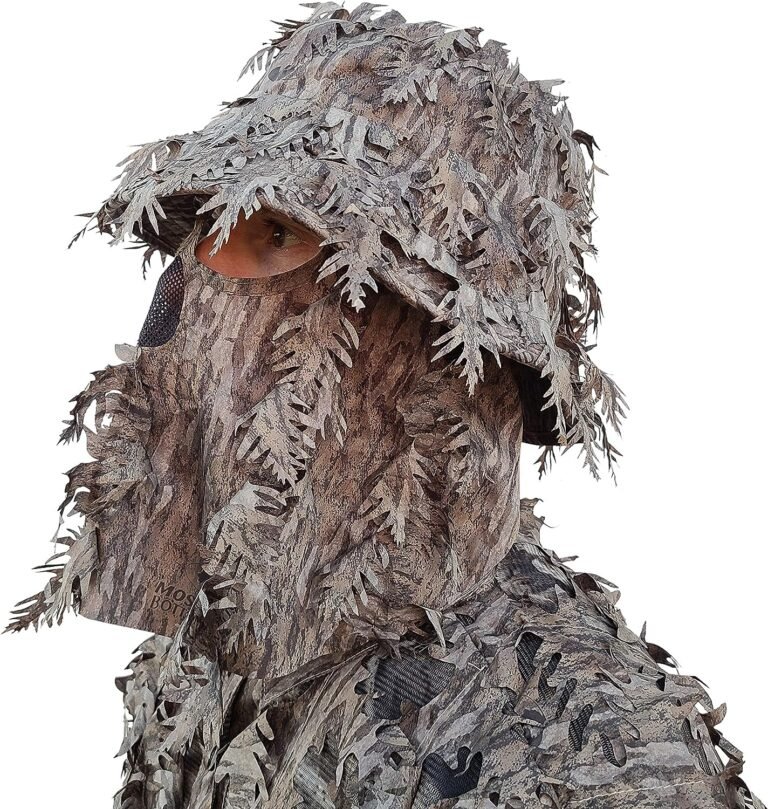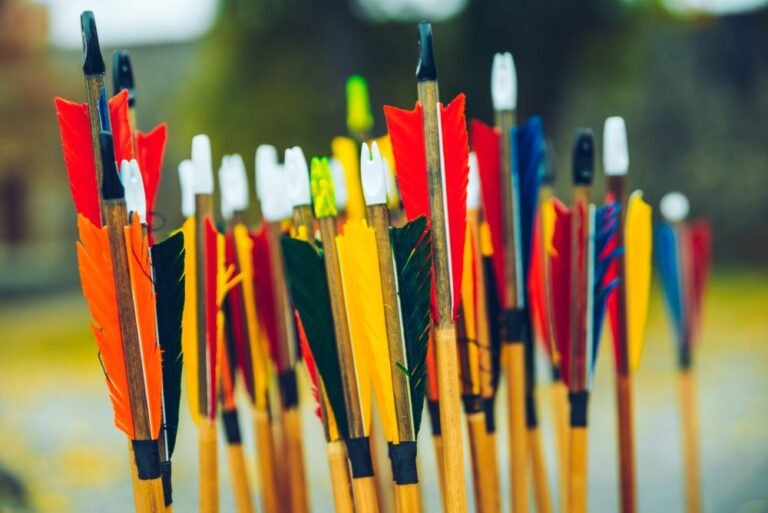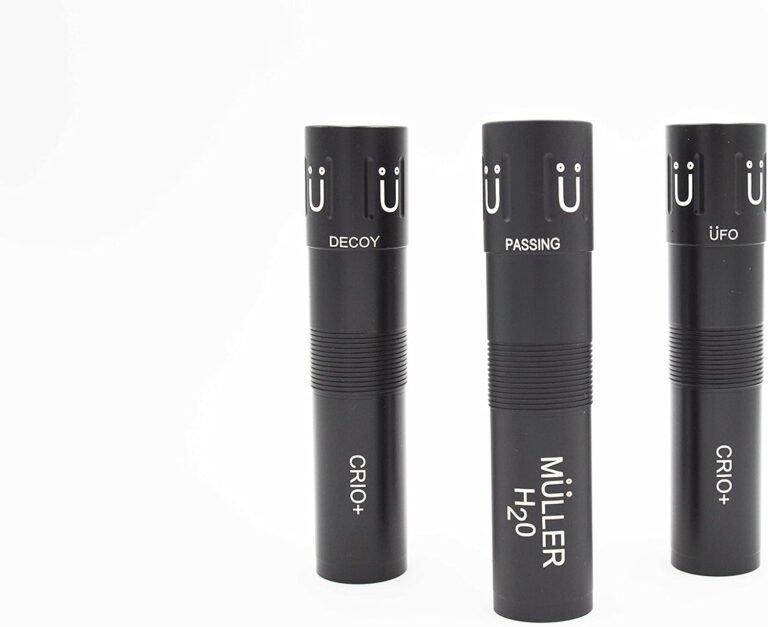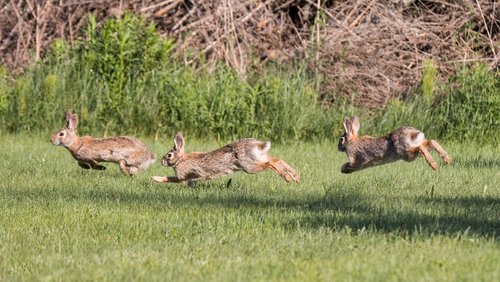Rabbit Hunting: Everything You Need to Know
The crisp morning air burned my lungs as I tracked fresh rabbit prints in the snow. After three unsuccessful hunting trips, I was about to discover the simple technique that would change everything – and you won’t believe how basic it was. This is rabbit hunting 101.
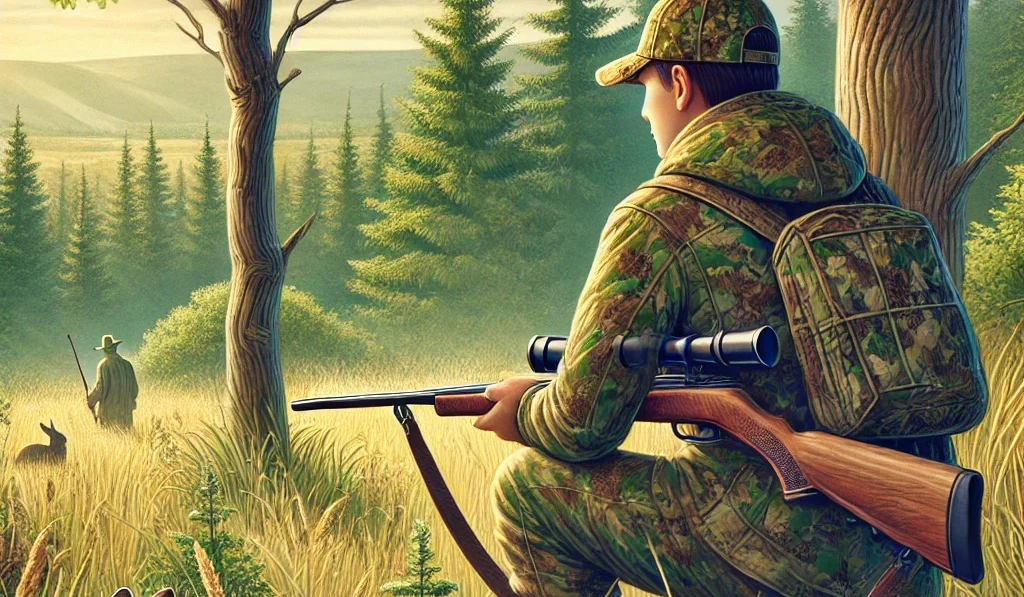
The thrill of rabbit hunting goes beyond just the chase. As a sport that’s been passed down through generations, it combines outdoor skills, wildlife knowledge, and good old-fashioned patience. Whether you’re looking to put food on the table or seeking a new outdoor adventure, rabbit hunting offers an accessible entry point into the hunting world.
But here’s the thing – most new hunters make the same crushing mistakes that leave them empty-handed and frustrated. I know because I made them all. After years of refining my approach and learning from seasoned hunters, I’ve discovered what actually works (and what’s just old wives’ tales).
In this complete guide, you’ll learn:
- The exact gear you need (without breaking the bank)
- Where to find rabbits (hint: it’s not where most people look)
- Step-by-step hunting techniques that work in any season
- Common mistakes that scare rabbits away (and how to avoid them)
Let’s turn you into a confident rabbit hunter – without the years of trial and error I went through.
Getting Started with Rabbit Hunting
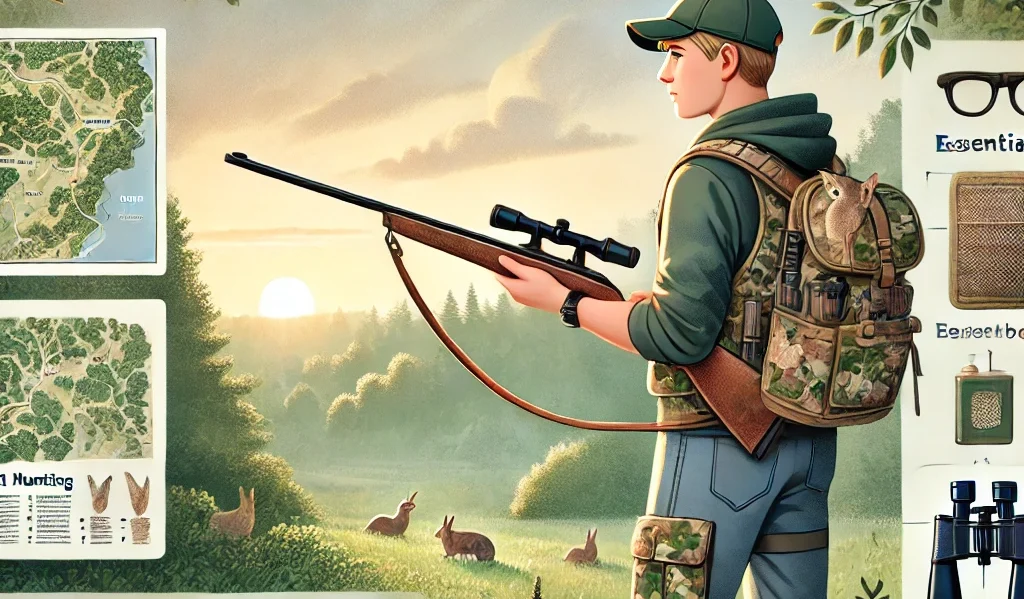
Best Seasons and Times
The success of your rabbit hunt often comes down to timing. Cottontails are most active at dawn and dusk, which hunters call the “golden hours.” While you can hunt rabbits year-round in most states, here’s when you’ll have the best luck:
- Early Fall: Perfect weather and visibility
- Winter: Easier tracking in snow
- Early Morning: First 2-3 hours after sunrise
- Late Afternoon: Last 2 hours before sunset
Pro Tip: Rabbits are more active on cloudy days, especially after a light rain when they come out to feed.
Required Licenses and Regulations
Before you grab your gear, let’s handle the legal stuff:
- State hunting license requirement
- Small game permit
- Seasonal bag limits
- Legal hunting hours
- Property permission needs
Always check your local Department of Natural Resources website for current regulations – they change yearly.
Safety First: The Non-Negotiables
1. Basic Firearm Safety
- Treat every gun as if it’s loaded
- Keep your finger off the trigger until it is ready
- Know your target and what’s beyond
- Keep the muzzle pointed in a safe direction
2. Personal Safety
- Wear a blaze orange vest and hat
- Let someone know your hunting location
- Carry a basic first-aid kit
- Bring an emergency communication device
Choosing Your Firearm: Top 3 Recommended Options
.22 LR Rimfire Rifle (Ruger 10/22 shown)
Key Advantages
- Low recoil: The .22 LR cartridge produces minimal recoil, making it easy to shoot accurately, especially for younger or less experienced hunters.
- Quiet report: The .22 LR’s relatively quiet report allows for stealthy hunting, minimizing the risk of scaring off rabbits.
- Affordable ammunition: .22 LR ammunition is inexpensive, making it a cost-effective choice for practice and hunting.
- Accuracy: Many .22 LR rifles are capable of excellent accuracy, allowing for precise shots at moderate distances.
Considerations
- Effective range: While .22 LR rifles can be accurate at longer ranges, their effectiveness decreases significantly beyond 50-75 yards. Most rabbit hunting situations occur within this range.
- Shot placement: For a humane kill, it’s crucial to aim for a vital area, such as the head or heart. A well-placed shot will ensure a quick and clean kill.
- Ammunition choice: Different types of .22 LR ammunition can vary in performance. Hollow-point or soft-point bullets are often preferred for hunting as they expand upon impact, increasing their stopping power.
Recommendations
- Ruger 10/22: A highly customizable and reliable semi-automatic rifle, often considered the gold standard for .22 LR rifles.
- Savage Mark II: A bolt-action rifle known for its accuracy and a wide range of models.
- Marlin Model 60: A popular semi-automatic rifle, often considered one of the most affordable and reliable options.
Ammunition Recommendations
Hollow Point Ammunition
- CCI Mini-Mag: This round is known for its accuracy and reliable expansion, making it a popular choice for small-game hunting.
- Winchester M22HV: This high-velocity round offers good penetration and expansion, making it effective on rabbits, especially at longer ranges.
Solid Point Ammunition
- Federal Champion: This affordable round is a solid choice for target practice and small-game hunting. While it may not expand as dramatically as a hollow point, it offers good penetration and accuracy.
12 Gauge Shotgun (Remington 870 shown below)
Key Advantages
- Versatility: A 12-gauge shotgun can be used for a variety of other game, making it a versatile choice for hunters.
- Power: The 12-gauge’s powerful shot can effectively take down rabbits at longer ranges.
- Shot Pattern: A 12-gauge shotgun can produce a dense shot pattern, increasing the chances of hitting a fast-moving rabbit.
Considerations
- Recoil: 12-gauge shotguns can have significant recoil, especially for younger or less experienced hunters.
- Weight: 12-gauge shotguns can be heavier, which may make them more tiring to carry for extended periods.
- Ammunition Cost: 12-gauge ammunition can be more expensive than .22 LR.
Recommendations
- Remington 870: A legendary pump-action shotgun known for its durability and versatility.
- Mossberg 500: Another popular pump-action shotgun offering various configurations and affordable options.
- Benelli Super Black Eagle: A high-end semi-automatic shotgun known for its reliability and fast-cycling action.
For rabbit hunting, a 12-gauge shotgun should be loaded with smaller shot sizes, such as No. 6 or No. 7. These smaller shot sizes will minimize damage to the meat while still providing effective stopping power.
While a 12-gauge shotgun can be an effective tool for rabbit hunting, it’s important to consider your needs and preferences. If you’re looking for a lighter, less-recoil option, a 20-gauge shotgun may be better.
20 Gauge Shotgun

Key Advantages
- Reduced Recoil: 20-gauge shotguns typically have less recoil than 12-gauge, making them more comfortable to shoot, especially for younger or less experienced hunters.
- Lighter Weight: 20-gauge shotguns are generally lighter than 12-gauge, making them easier to carry for extended periods.
- Effective Range: 20-gauge shotguns can effectively take down rabbits at moderate ranges, making them suitable for most rabbit hunting situations.
- Versatility: While primarily used for small game, 20-gauge shotguns can also handle larger game, such as waterfowl and upland birds, with the right ammunition.
Considerations
- Less Power: Compared to a 12-gauge, a 20-gauge shotgun has slightly less power, which may limit its effectiveness at longer ranges or against larger game.
- Ammunition Availability: While widely available, 20-gauge ammunition may not be as readily available as 12-gauge.
Popular 20-gauge shotgun options for rabbit hunting
- Mossberg 500: A versatile shotgun configured for various purposes, including rabbit hunting.
- Remington 870: A classic pump-action shotgun, available in 20 gauge for lighter recoil and reduced shot pattern.
- Stoeger M3500: An affordable semi-automatic shotgun known for its reliability and soft-shooting action.
Ammunition Recommendations
For rabbit hunting, a 20-gauge shotgun should be loaded with smaller shot sizes, such as No. 6 or No. 7. These smaller shot sizes will minimize damage to the meat while still providing effective stopping power.
Overall, a 20-gauge shotgun is a great choice for rabbit hunters who want a balance of power, recoil, and weight. It offers a comfortable shooting experience and is effective for most rabbit hunting situations.
Clothing That Works
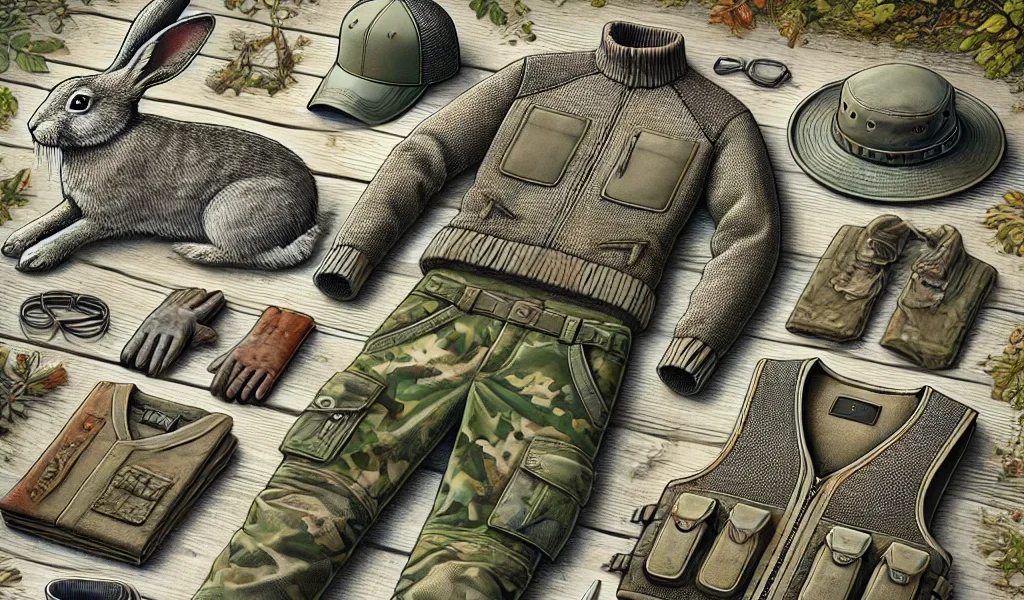
Essential Layers
- Base layer: Moisture-wicking material
- Mid layer: Insulating fleece
- Outer layer: Weather-resistant jacket
- Brush pants: Thick enough for thorns
Footwear
- Waterproof boots (8-inch height minimum)
- Thick socks (wool blend preferred)
- Optional gaiters for thorny areas
Must-Have Accessories
Basic Kit
- Game bag or vest ($20-30)
- Sharp knife for field dressing
- LED headlamp
- Water bottle and snacks
- Basic first aid supplies
Optional but Useful
- Rabbit call ($10-15)
- Binoculars (compact)
- GPS or compass
- Work gloves
Working with Dogs
If you’re considering a hunting companion:
Best Breeds
- Beagles (traditional choice)
- Jack Russell Terriers
- Basset Hounds
Basic Training Needs
- Scent training
- Basic commands
- Field experience
- Pack coordination
Finding Rabbit Habitat

Prime Rabbit Territory
Think like a rabbit – they need three things: food, cover, and escape routes.
Best Locations
- Field edges with thick brush
- Overgrown fence rows
- Young forest clear-cuts
- Briar patches
- Agricultural field borders
- Old brush piles
Food Sources to Look For
- Clover patches
- Berry bushes
- Young tree bark
- Garden areas
- Grass shoots
- Winter wheat fields
Reading Rabbit Signs
These telltale signs mean rabbits are active:
Fresh Evidence
- Droppings (dark, pea-sized pellets)
- Fresh tracks (especially in snow/mud)
- Bark stripped from small trees
- Clipped vegetation
- Well-worn trails in the grass
Identifying Active Areas
- Look for converging trails
- Check for fresh droppings
- Notice recently browsed plants
- Spot resting depressions
Understanding Rabbit Behavior
Knowing their habits improves your success:
Daily Patterns
- Most active at dawn/dusk
- Rest during mid-day
- Feed heavily before storms
- More movement on cloudy days
Seasonal Changes
- Spring: Focus on new growth
- Summer: Stay near thick cover
- Fall: More active feeding
- Winter: Concentrate near food sources
Pro Tip: Rabbits typically stay within a 2-5 acre area their entire lives. Once you find a good spot, mark it – you can return throughout the season.
Weather Impact
Different conditions require different strategies:
Best Hunting Weather
- Light overcast days
- After light rain
- Fresh snow
- Calm winds
Challenging Conditions
- Heavy rain
- Strong winds
- Deep snow
- Extreme cold





